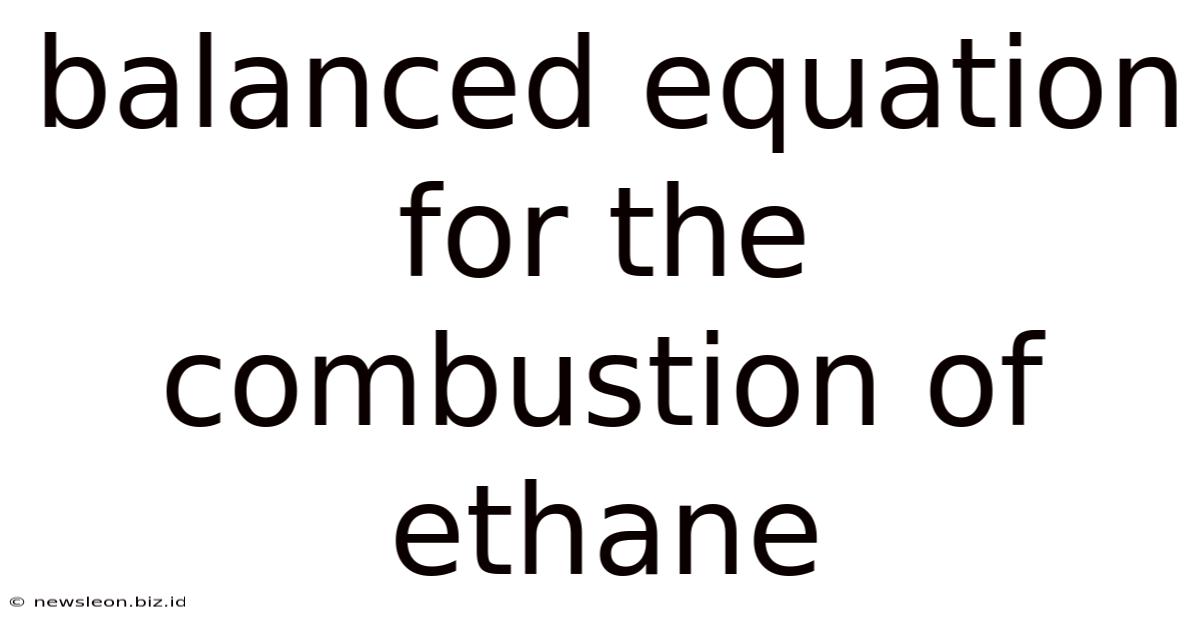Balanced Equation For The Combustion Of Ethane
News Leon
May 05, 2025 · 4 min read

Table of Contents
The Balanced Equation for the Combustion of Ethane: A Deep Dive
The combustion of ethane, a crucial reaction in various industrial processes and a fundamental concept in chemistry, provides an excellent case study for understanding stoichiometry and chemical reactions. This comprehensive article will delve into the balanced equation for the combustion of ethane, exploring its implications, variations, and practical applications. We'll cover the theoretical aspects, practical considerations, and even touch upon the environmental impact of this reaction.
Understanding the Basics: Ethane and Combustion
Before diving into the balanced equation, let's establish a foundation. Ethane (C₂H₆) is a simple alkane, a hydrocarbon composed solely of carbon and hydrogen atoms. It's a colorless, odorless gas at room temperature and plays a vital role as a component of natural gas.
Combustion, in its simplest definition, is a rapid chemical reaction between a substance and an oxidant, usually oxygen (O₂), producing heat and light. This exothermic reaction releases energy, making it a valuable source of power in various industries.
The Balanced Equation: The Heart of the Matter
The combustion of ethane involves the reaction of ethane with oxygen to produce carbon dioxide (CO₂) and water (H₂O). The unbalanced equation is:
C₂H₆ + O₂ → CO₂ + H₂O
This equation is unbalanced because the number of atoms of each element is not equal on both sides. To balance it, we must ensure that the number of carbon, hydrogen, and oxygen atoms is the same on the reactant (left) and product (right) sides.
The balanced equation for the complete combustion of ethane is:
2C₂H₆ + 7O₂ → 4CO₂ + 6H₂O
This equation signifies that two molecules of ethane react with seven molecules of oxygen to produce four molecules of carbon dioxide and six molecules of water. This balanced equation is crucial for various applications, including:
- Stoichiometric calculations: Determining the amount of reactants needed or products formed.
- Energy calculations: Calculating the heat released during combustion.
- Process optimization: Understanding the optimal ratio of reactants for efficient combustion.
Complete vs. Incomplete Combustion: A Crucial Distinction
The balanced equation presented above represents complete combustion. This means that sufficient oxygen is available for the complete oxidation of ethane into carbon dioxide and water. However, if the oxygen supply is limited, incomplete combustion occurs, leading to the formation of other products, such as:
- Carbon monoxide (CO): A highly toxic gas.
- Soot (carbon particles): Unburnt carbon.
- Other hydrocarbons: Partially oxidized ethane molecules.
The equations for incomplete combustion are more complex and vary depending on the oxygen availability. Here are a couple of examples:
Incomplete Combustion (Example 1 - producing CO):
2C₂H₆ + 5O₂ → 4CO + 6H₂O
Incomplete Combustion (Example 2 - producing soot and CO):
2C₂H₆ + 3O₂ → 4C + 6H₂O
The formation of carbon monoxide highlights the significant safety concerns associated with incomplete combustion. Carbon monoxide is odorless and colorless, making it a particularly dangerous pollutant.
Practical Applications and Industrial Significance
The combustion of ethane is fundamental to several industrial processes:
- Power generation: Ethane is used as a fuel source in power plants, generating electricity through combustion turbines.
- Chemical synthesis: Ethane serves as a feedstock for the production of various chemicals, including ethylene, a crucial building block for plastics. The controlled combustion of ethane can be used to regulate the production of these chemicals.
- Heating: In certain applications, ethane is used for heating purposes due to its high heat content.
Environmental Implications: A Balancing Act
While ethane combustion provides energy and facilitates various industrial processes, it's essential to acknowledge its environmental implications. The primary concerns are:
- Greenhouse gas emissions: The combustion of ethane releases carbon dioxide, a significant greenhouse gas contributing to climate change.
- Air pollution: Incomplete combustion can release harmful pollutants, such as carbon monoxide, particulate matter, and unburnt hydrocarbons, impacting air quality and human health.
Mitigating Environmental Impacts: Strategies and Technologies
Several strategies can help mitigate the negative environmental effects of ethane combustion:
- Improving combustion efficiency: Optimizing combustion processes to ensure complete oxidation minimizes the formation of pollutants.
- Carbon capture and storage (CCS): Technologies are being developed to capture CO₂ emissions and store them underground, preventing their release into the atmosphere.
- Transitioning to cleaner energy sources: Reducing reliance on fossil fuels like ethane and transitioning to renewable energy sources is crucial for long-term sustainability.
Beyond the Basics: Advanced Considerations
The balanced equation provides a simplified representation of a complex reaction. Several factors can influence the actual combustion process:
- Temperature: The rate of combustion and the extent of complete oxidation are highly temperature-dependent.
- Pressure: Pressure affects the reaction rate and equilibrium.
- Presence of catalysts: Catalysts can accelerate the reaction and improve combustion efficiency.
Understanding these factors is vital for optimizing combustion processes in industrial settings.
Conclusion: A Powerful Reaction with Environmental Responsibilities
The balanced equation for the combustion of ethane, 2C₂H₆ + 7O₂ → 4CO₂ + 6H₂O, serves as a cornerstone for understanding this crucial chemical reaction. Its importance in various industrial applications is undeniable, but we must approach its utilization with awareness of its environmental consequences. By implementing efficient combustion technologies, employing carbon capture strategies, and transitioning toward cleaner energy sources, we can harness the benefits of ethane combustion while minimizing its detrimental impacts on the environment. The future of ethane usage lies in finding a balance between energy needs and environmental responsibility.
Latest Posts
Related Post
Thank you for visiting our website which covers about Balanced Equation For The Combustion Of Ethane . We hope the information provided has been useful to you. Feel free to contact us if you have any questions or need further assistance. See you next time and don't miss to bookmark.